Simply steamed or boiled, shrimp can be turned into a wonderfuldish. Jumbo shrimp, about 20 centimeters long, are often grilled,whereas small shrimp are preserved in salt to be used as a condiment.Rich in protein and minerals, shrimp are loved around the world fortheir sweet and savory flavor.
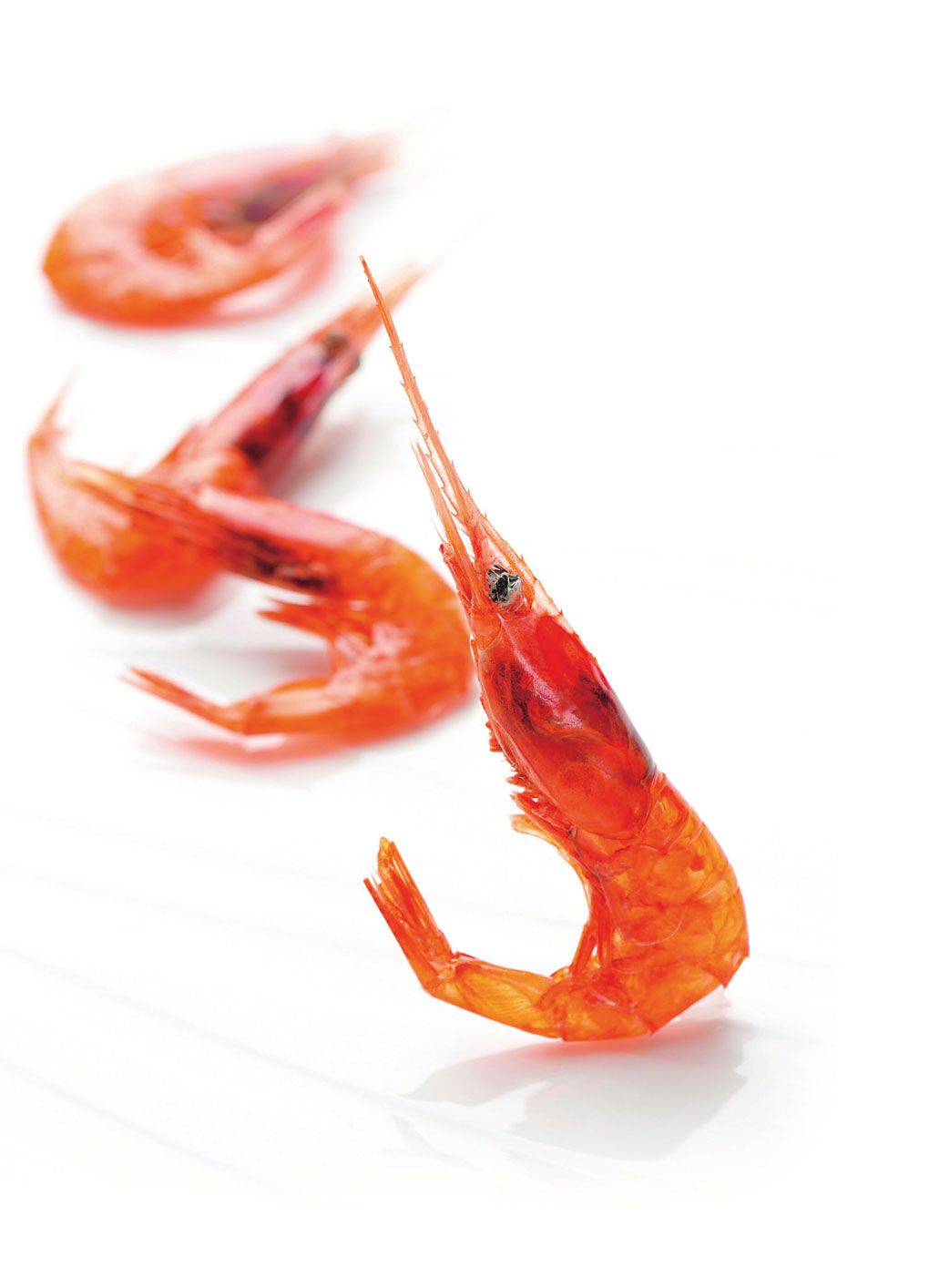
Shrimp are popular all over the world for their sweet and savoryflavor. They taste especially good in the late fall and winter, when theiramino acid glycine content rises.
© PIXTA
In the coastal waters of the Korean peninsula, shrimpare in season from late autumn through winter. This isrelated to the survival of shrimp as crustaceans. Whilefish become fatty and grow bigger to survive the cold win�ters, crustaceans, with less body fat, have a few differentstrategies to survive. One is to move to the deep seas wherethe water temperature is higher; another is to increase thepercentage of their body constituents that do not freeze.
Therefore, shrimp stay in Korea’s coastal waters fromspring through autumn and move away for the winter. Inautumn, they prepare for the cold by increasing the contentof omega-3 fatty acids in their body, as well as the aminoacid glycine, which is responsible for their sweet flavor.This is why autumn is the best season to enjoy the healthiestand tastiest shrimp, or saeu, in Korea.
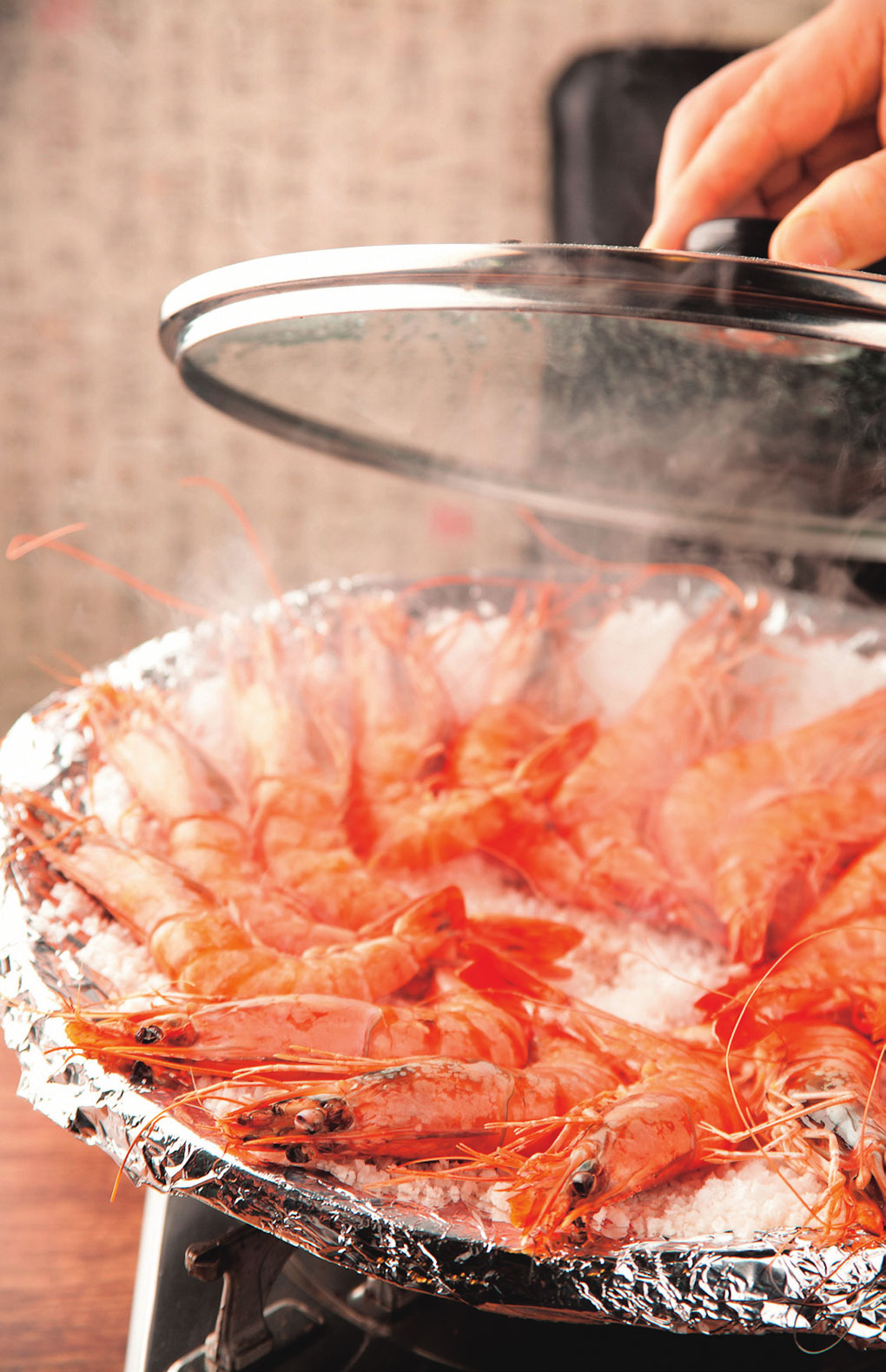
Jumbo shrimp from the temperate and subtropical waters of Koreaand China make a great dish when simply roasted on coarse salt ina skillet.
© gettyimages
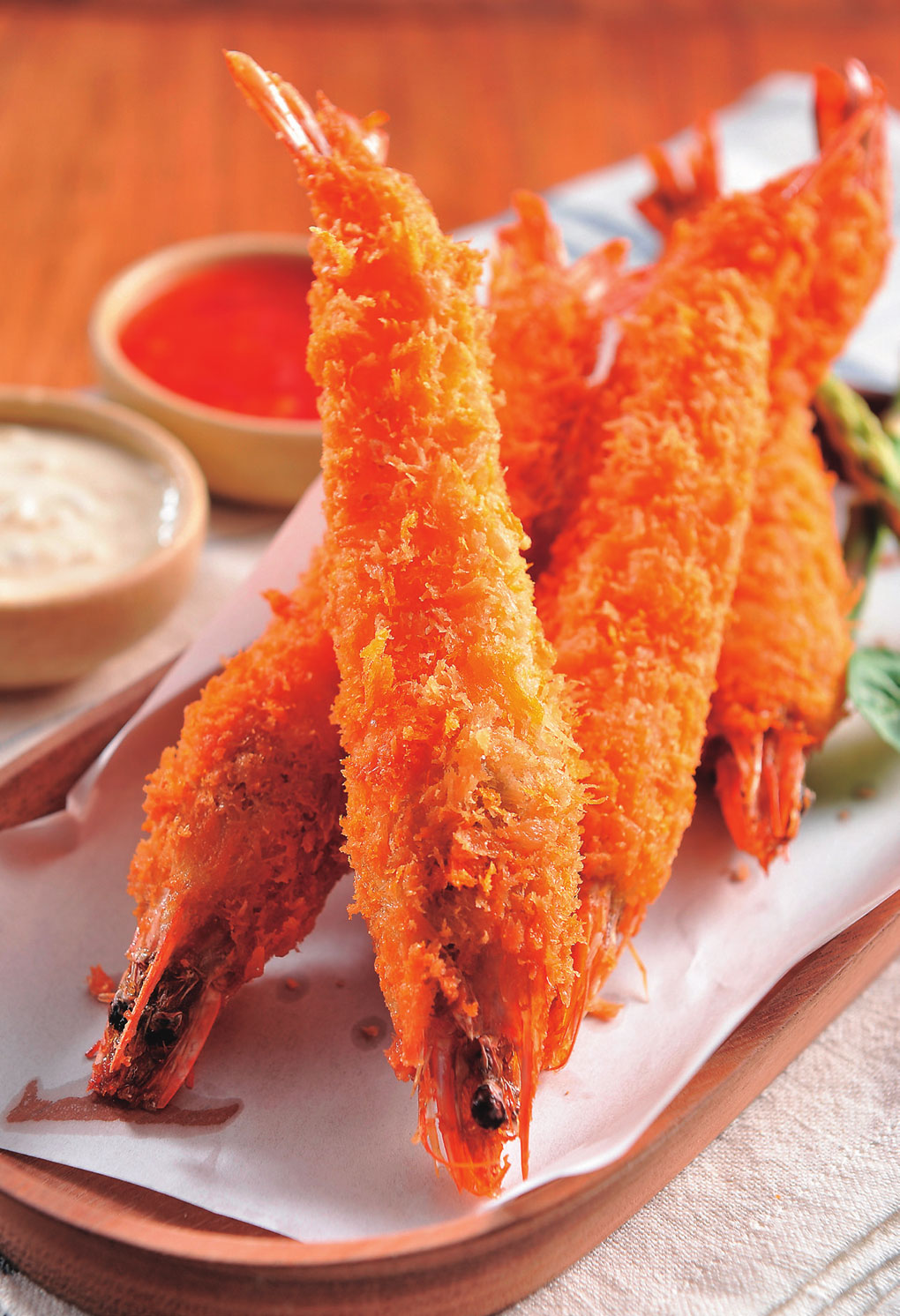
Aside from grilling, deep-frying is another typical way of cookingjumbo shrimp. Coated with flour, egg batter and breadcrumbs, theshrimp are deep-fried whole with the shell on.
© gettyimages
Some people avoid shrimp due toconcern for their cholesterol levels.But that isn’t strictly necessary.Some 80 percent of the cholesterolin the blood is naturally producedby the body, which means it isn’teasy to lower cholesterol throughdiet alone
Pickling and Fermenting
Shrimp are cooked in many ways, all of which are relativelysimple. Roasting shrimp on coarse salt in a skillet or briefly boiling or steaming them brings out a sweet, nutty flavor.The shrimp’s sweet flesh can also be eaten raw, with theheads boiled separately. Among the shrimp varieties livingin Korea’s coastal waters is the jumbo shrimp, more than20 centimeters long, which is called dohwa saeu, meaning “peach blossom shrimp.” As its name suggests, this is afancy-looking shrimp with a firm texture and sweet flavor,good enough for a main course in fine dining restaurants.
Small shrimp called jeot saeu, however, account for thegreatest proportion of shrimp caught in domestic waters.Actually, these small shrimp make up the largest catch allacross the globe. Unlike jumbo shrimp, which are mostly grilled, smaller varieties are soft and spoil easily, so theyare packed with salt on the fishing boat as soon as they arecaught.
Around the world, small shrimp are fermented to makesauces, pastes and other condiments used for various dish�es. Xia gao (or xia jiang) in Hong Kong, kapi in Thailand,belacan in Malaysia, terasi in Indonesia and ma˘´m tôm inVietnam are different in name and type, but all have shrimpas their common ingredient. In Korea, salted and fermentedshrimp, called saeujeot, is used as a condiment for manydishes, including kimchi.
Saeujang, meanwhile, is not a condiment but a dish onits own, consisting of raw shrimp aged in soy sauce that hasbeen boiled with vegetables and spices. Its delectable flavoris d by the combination of raw shrimp and the sweet,savory and salty taste of soy sauce. In this way, it’s muchlike gejang, which is raw crab preserved in soy sauce prepared in a similar way. The texture of the shrimp in saeu�jang is unique, falling somewhere between cooked and raw.Eaten with freshly cooked rice, it is dubbed a “rice thief,”meaning it’s so delicious that the rice eaten with it quicklydisappears.
Cholesterol
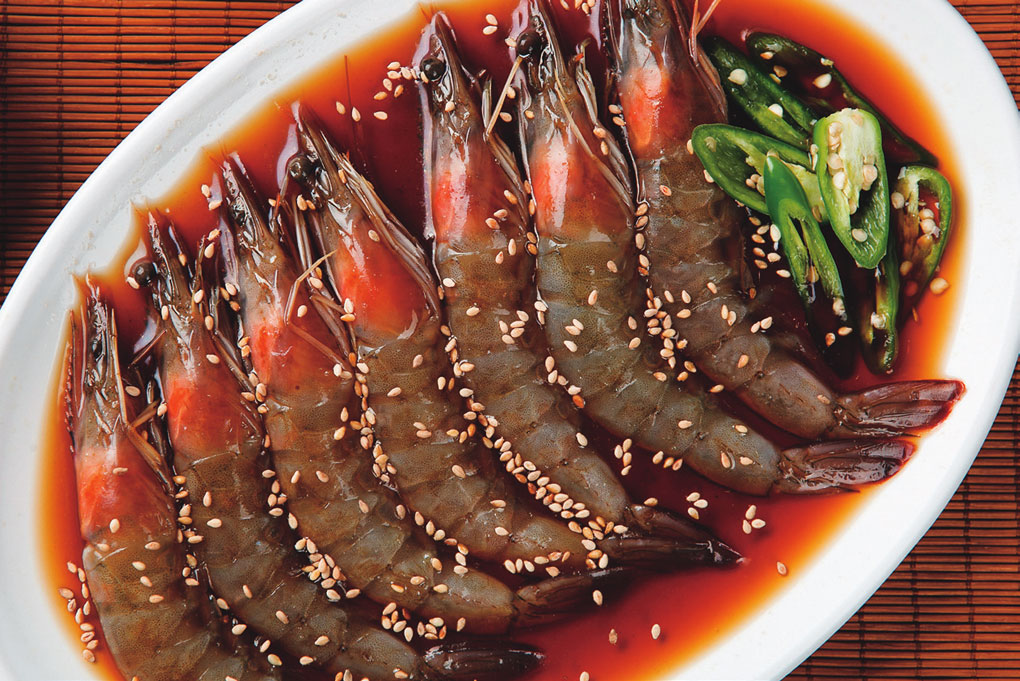
Koreans also enjoy saeujang, a dish consisting of raw shrimp aged insoy sauce that has been boiled with vegetables and spices. © Shutterstock
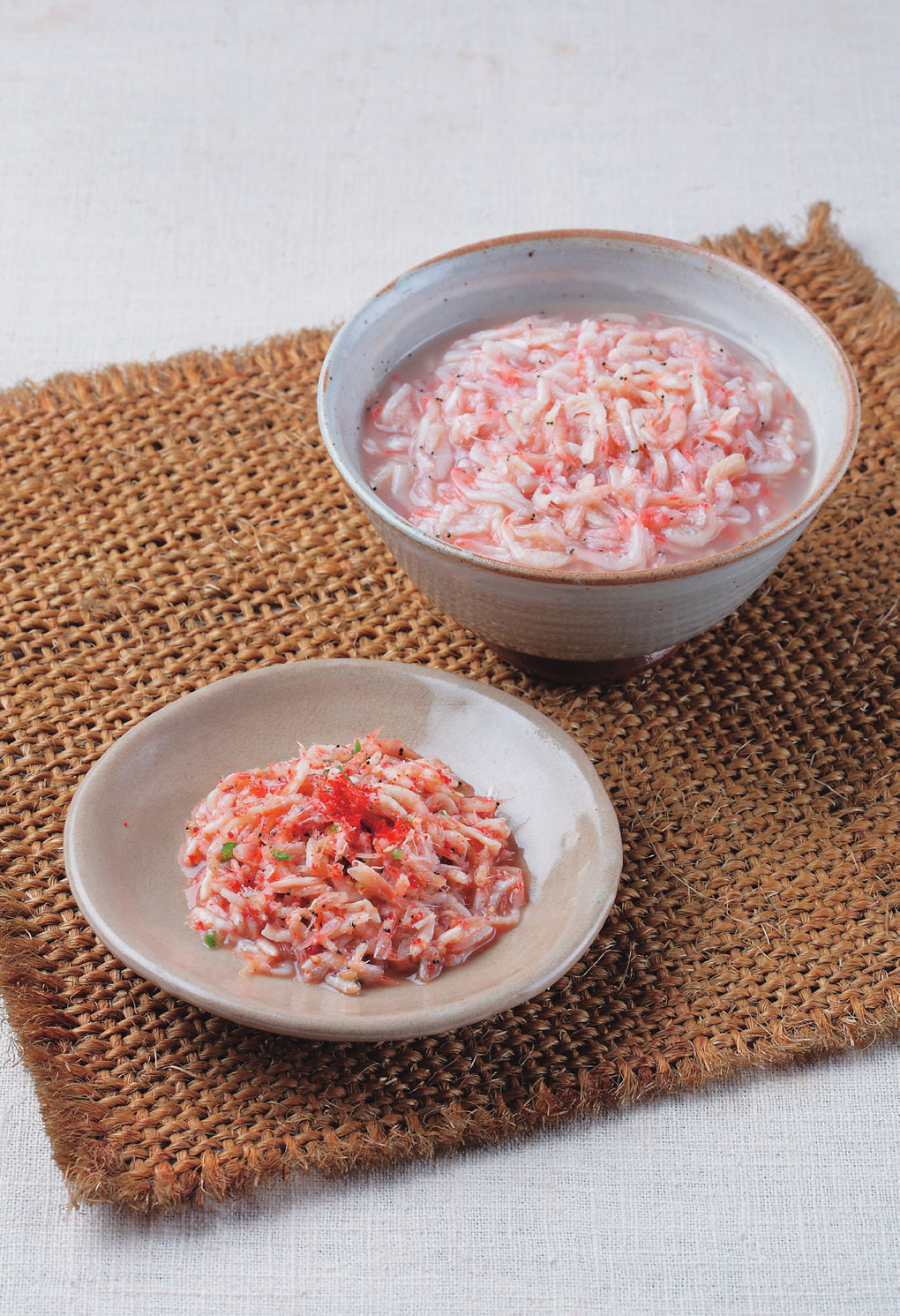
Saeujeot, salted and fermented small shrimp, is used as a condimentin various dishes and when making kimchi. Mixed with chopped hotpepper, garlic, red pepper powder, sesame seeds and sesame oil, saeujeotis a side dish that whets the appetite in summer.© Institute of Korean Royal Cuisine
Shrimp has a high cholesterol content of 189 mg per 100grams. This is because cholesterol is an essential nutrientfor shrimp’s growth: it is needed to produce the hormonethat accelerates the shedding process as shrimp outgrow andreplace their exoskeleton. Cholesterol is also vital to humanlife, necessary for brain development and a precursor forthe biosynthesis of sex hormones and Vitamin D, “the sun�shine vitamin.” Vitamin D is made in human skin when it isexposed to sunlight, and accordingly, many people have adeficiency in winter.
While cholesterol is naturally produced in the humanbody, this is not the case for crustaceans. Whether farmed orwild, shrimp cannot grow well without sufficient cholesterol intake. This means that farmed shrimp must be given feedwith adequate cholesterol content. Cholesterol can be foundin several parts of the shrimp: the fleshy body has relative�ly little, while the head has a lot. The savory shrimp headis, precisely speaking, a combination of head and chest, andcontains internal organs high in fat and cholesterol. Theinner organs alone contain seven times more fat and two orthree times more cholesterol than the flesh. The end part ofthe intestinal tract, called the “vein” in English, also has ahigh percentage of cholesterol, although the actual amountit contains is small.
Many foods are subject to myth, and so is the shrimp.It is said that a shrimp’s tail contains a certain substancethat inhibits the absorption of cholesterol. But this is totallyunfounded. A shrimp’s hard skin consists of chitin, whichis not digested or absorbed by the body. Only through chemical process involving a strong alkali can chitin be bro�ken down into small molecules called keto acids, which areknown to be effective in lowering the cholesterol level inblood. No amount of chewing on a shrimp’s shells or tails isenough to turn chitin into keto acids. Eating the shells is stilla good way to enjoy the shrimp, however; the shells containamino acids, sugars and pigments that add to the savory flavor and aroma of cooked shrimp, and also keep the flavorcomponents in the flesh from melting away during cooking.
Shrinking Catch
Some people avoid shrimp due to concern for their cholesterol levels. But that isn’t strictly necessary. Some 80 percent of the cholesterol in the blood is naturally producedby the body, which means it isn’t easy to lower cholesterolthrough diet alone. Actually, shrimp may have more causefor worry about excessive cholesterol consumption. Togrow, their feed should have a cholesterol content of about0.5 percent, but once that content reaches 5 percent, theirgrowth is suppressed instead.
Shrimp crackers, a deep-fried snack made from a mixture of ground shrimp and starch, are especially popular inAsian countries. In Korea, medium-sized shrimp were usedto make the crackers until the 1990s, but due to decreasinghauls, blue shrimp, or kkotsaeu, are used these days. Likeany other food ingredient, shrimp are not unlimited in supply. If we fail to consider the impact of shrimp fishing andthe sustainability of shrimp farming, we might not be able to enjoy the diverse flavors of shrimp in the not-so-distantfuture.
Yi Saek (1328-1396), a man of letters who lived duringthe late Goryeo Dynasty, wrote to express his thanks for agift of jumbo shrimp: “They courteously bow to one another; appreciating them deeply will help enrich the Way.” Theshrimp, with their long whiskers and curved bodies, proba�bly reminded the famed Neo-Confucian scholar of humansbowing in humility toward one another. Similarly, weneed to adopt a humble attitude and look around us to findways to coexist with nature while enjoying the rich taste ofshrimp in autumn.